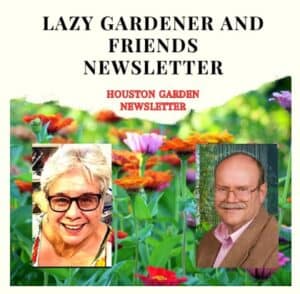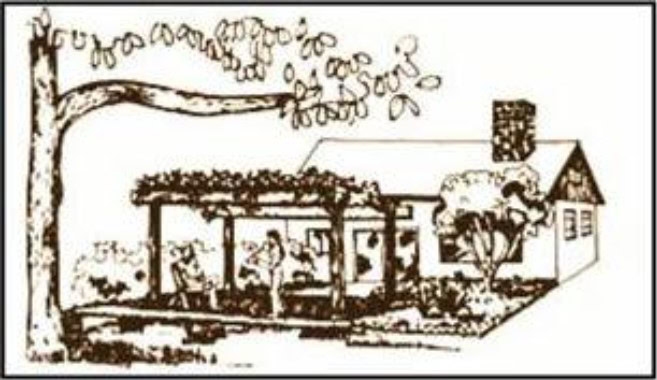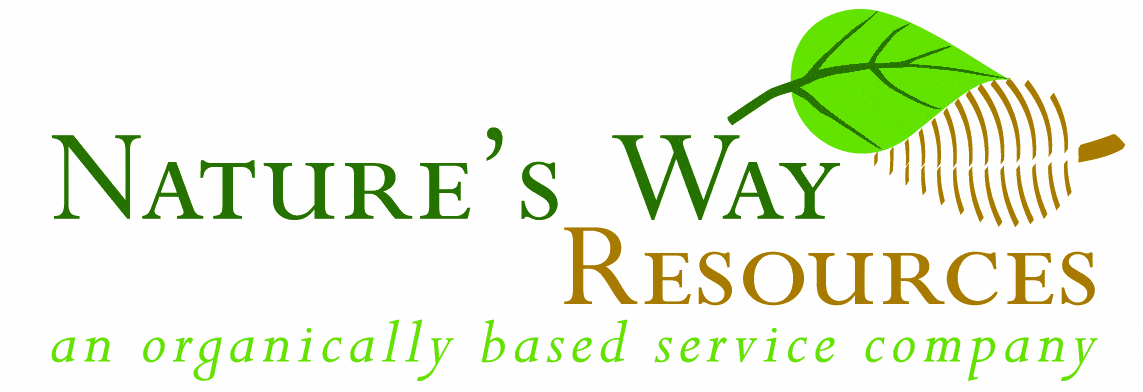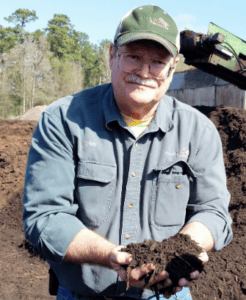 Nature’s Way Resources is proud to produce & email you this free weekly newsletter. We have no ads, but sponsors do graciously help support this project as a public service. Please note their names below & show your gratitude for this free service by patronizing their businesses! To become a sponsor, call (936) 273-1200
Nature’s Way Resources is proud to produce & email you this free weekly newsletter. We have no ads, but sponsors do graciously help support this project as a public service. Please note their names below & show your gratitude for this free service by patronizing their businesses! To become a sponsor, call (936) 273-1200
Nature’s Way Resources owner John Ferguson, “The Lazy Gardener” Brenda Beust Smith and Pablo Hernandez welcome your feedback and are so grateful to the many horticulturists who contribute their expertise
Click here to join our email list
CLICK HERE for PDFs OF PAST LG&F NEWSLETTERS

Pause for a moment and you shall find, the old oak tree is a friend of yours and mine. Author Unknown
HOUSTON’S SUMMER HEAT FORECAST ‘SCARY’ — BUT PLANTS CAN HELP
BY BRENDA BEUST SMITH
ARE YOUR PLANTS EARNING THEIR KEEP — INSIDE AND OUT? If you think your electrical bills are high now, wait until summer hits in full force. We place a LOT of emphasis on making our homes energy-efficient. But less on contributions our landscapes can potentially make.
This coming summer, Texas A&M cli`mate scientist ANDREW DESSLER predicts, is “… certainly going to be one of the hottest years in the record.” So it’s important to realize trees, bushes, shrubs and tall grasses actually lower adjacent temps through a process called “evapotranspiration” that potentially can provide enough shade/cooling to reduce 25% of typical household energy usage.
- Trees give off water vapor (transpiration) that cools surrounding air (just as sweating cools our skin).
- Temperatures can often be 10 degrees lower in the shade.
- Urban forest temps are on average 2.9°F lower than unforested urban areas. Ill-positioned trees and plants can actually raise electric bills. (U.S. Department of Energy (and almost all landscaping experts)
Tree planting advice can be very confusing. Some say to plant deciduous trees on west side to provide shade in summer and allow heating sun rays to warm house in winter. Others say to plant evergreens for same reason in summer to protect against freezing winds in winter. Your choice but try to stick to natives! I like DR. WILLIAM C. WELCH’s advice in this article: https://aggie-hort.tamu.edu/extension/homelandscape/energy/energy.html
A small part:
- Take a good look at your yard, note “situations” listed here.
- Deciduous trees with wide-spreading canopies cast more shade than trees with cone-shaped canopies.
- Know adult sizes of specific trees in our area (!) before planting — both height and canopy spread. (They’re also often much wider here due to subtropical climate.)
- Allow space for full growth!!
- Use tall shrubs on west side to protect outdoor air conditioning unit from afternoon sun. Be careful nothing drops leaves into the unit.
Experts say not only will your AC unit use less energy to cool itself down with west side protection, but this shading can help reduce indoor temperatures by up to 3 degrees Fahrenheit and increase its energy efficiency by 10%. Just be sure trees or shrubs won’t obstruct access to either the AC unit or airflow.
Not enough room for a large tree?
- Large shrubs/vines on lattice sheets or frames will shade west side in summer, and allow warming sun rays through in winter. Good choices: coral vine or hyacinth bean vine. Or, a deciduous tree (fruits!) espaliered on the lattice!
NOTE: Do not allow lattice to touch the ground or the house. You always want good air circulation between house and plants. Build a strong frame, using treated lumber. Attach the lattice to the frame slightly above ground level. Secure well.
Many water bills include an added “electricity” charge for various operations necessary for getting & maintaining water to your site. The less water used on your landscape, the more money you may save on water bills. Ask about that!
Lower those potential charges by mulching beds to reduce moisture lost to evaporation. Even better, pick low water plantings, especially natives.
Remember, Texas has MANY different soil and weather conditions. Do a little research to make sure you put those from, say, West Texas in conditions they require. Very different from our Gulf Coast!
Wonder why any particular native plant you’re trying isn’t thriving? Check it’s native environment and see if you can make it feel more at home!

Now this is NOT Lazy Gardening! But . . . L to r: umbrella oleander topiary, ‘Sister Agnes’ oleander and ‘Isadore Dryer’ oleander
SALLY J. in West Houston wants to know how to ‘topiary’ her oleander bush so she can plant lower things around it. She’s starting out with a young one which is the best idea. It’s easy, if you’ve got time and patience! A great resource and general oleander guide: “The Handbook On Oleanders” (paperback) by Richard & Mary Helen Eggenberger (Tropical Plant Specialists)
Decide if you want a single or multi-trunk “tree.” The latter is the easiest. Select an uneven number of large, vigorous bottom branches (or just one) that naturally are forming a vase-like “bottom.” (Odd numbers look better for some reason.
Cut away other stems, as close to bottom as possible. On remaining stems, remove side branches up about 2-4 feet. Let them grow, but continue removing any new sprouts from base or from sides of remaining branches. The Handbook On Oleanders Paperback (1996) by Richard & Mary Helen Eggenberger
Takes patience. Oleanders want to be a shrub. But eventually it will get the idea and, because its one of our hardiest, most prolifically summer-blooming shrubs, it’ll be well worth the effort!
PLEASE NOTE: Before you warn oleanders are poisonous, remember: Just because an ornamental plant is popular does NOT mean it’s EDIBLE.
We single out 1 -2 plants as “poisonous,” which actually can mean anything from a mild stomach ache to worse. But we ignore the fact that many, if not most, common ornamentals can make you/your child/your pet even mildly sick if eaten either at wrong time or always.
Have you researched every single ornamental in your yard, or stalks, flowers, etc., to make sure they are always edible? Some are inedible when young, some when old, some just leaves or bark or flowers, some only at given point in their particular life cycle.
Train/teach children and pets NOT to eat ANY plants unless you say it’s ok. Just like you teach them not to run into the street, not to stick their fingers in an electrical outlets or to try and touch fire, etc.
John’s Corner
NEWS FROM THE WONDERFUL WORLD
OF SOIL AND PLANTS # 279
Subject: Healthy Soils
I often get asked, “What is a healthy soil?”
So, what is a healthy soil and how do we get there? Almost every gardening book I have ever read has some definition of a healthy soil. We go to the garden center and we see all these colorful bags making wild claims about how wonderful and great the product is. But is it really? How many of us have torn a hole in the bag when no one is looking so we can see what is inside? Experienced gardeners know that most of these products are worthless.
So again, what is a healthy soil?
Most folks would say it is a mix of sand, silt, and clay (topsoil) with some organic matter mixed in. But is that always true? What about the microbial content or the air and water in the soil? What about the available nutrients? What form are they in and how are they delivered?
What about the type of organic matter? Is it high quality humus that one gets from a good compost or is it sawdust or bark from the local sawmill?
In the last 20 years as our understanding of the tremendous importance of soil microbiology and the role it plays in plant growth and health has changed, it has caused our understanding of a healthy soil to change. I hope every gardener reading this newsletter has read the book “Teaming With Microbes” by now.
Is a healthy soil for cactus and succulents the same as a healthy soil for blueberries? Is a healthy soil for turf grass (ex. St. Augustine) the same as for trees? Is a healthy soil for bluebonnets the same as a healthy soil for swamp mallows or gingers?
As you can see from the questions above the answer varies depending on what we are growing. To have healthy soil we have learned that there are three major aspects that need to be looked at:
- 1st. We need to define, what is a healthy soil in relation to the plants we wish to grow
- 2nd. We need to quit destroying it
- 3rd. We need to nourish and replenish it
Hence the answer to the question, “What is a healthy soil?” is a combination of the components below:
- Organic matter from almost fresh to totally decomposed in the form of humus (humins, humic acid, fulmic acid, and ulmic acids)
- Minerals (nutrients, sand, silt, and clay)
- Elements in the soil major, minor, trace, micro, and we are now learning that even pico amounts of some elements affects soil, plants, and animal health.
- Soil life that includes microbes (ex. Bacteria and fungi), macrobes (earthworms, beetles, microarthropods, etc.)
- Air & water (includes the chemicals in them weather good or bad)
- Plant choices (soil that is good for one plant may be toxic to another)
- Care for, and do not destroy the health of the soil one has.
We will look at each component in detail over the next few weeks.
SPONSORSHIP
If you are interested in becoming a sponsor, please contact us at 936-273-1200 or send an e-mail to: lazygardenerandfriends@gmail.com
ABOUT US
BRENDA BEUST SMITH WE KNOW HER BEST AS THE LAZY GARDENER . . . but Brenda Beust Smith is also:
- a national award-winning writer & editor
- a nationally-published writer & photographer
- a national horticultural speaker
- a former Houston Chronicle reporter
When the Chronicle discontinued Brenda’s 45-year-old Lazy Gardener” print column — started in the early ’70s as a fun side-project to reporting, it then ranked as the longestrunning, continuously-published local newspaper column in the Greater Houston area. The name, she says, is not just fun, it’s true. Brenda’s gradual sideways step from reporter into gardening writing led first to an 18-year series of when-to-do-what Lazy Gardener Calendars, then to her Lazy Gardener’s Guide book which morphed into her Lazy Gardener’s Guide on CD, which she now emails free upon request. Brenda became a Harris County Master Gardener and, over the years, served on theboards of many Greater Houston area horticulture organizations. She hosted local radio and TV shows, most notably a 10+-year Lazy Gardener specialty shows on HoustonPBS (Ch. 8) and her call-in “EcoGardening” show on KPFT-FM. For over three decades, Brenda served as Assistant Production Manager of the GARDEN CLUB OF AMERICA’S “BULLETIN” magazine. Although still an active broad-based freelance writer, Brenda’s main focus now is THE LAZY GARDENER & FRIENDS HOUSTON GARDEN NEWSLETTER with John Ferguson and Pablo Hernandez of Nature’s Way Resources. A native of New Orleans and graduate of St. Agnes Academy and the University of Houston, Brenda lives in Humble, TX, and is married to the retired Aldine High School Coach Bill Smith. They have one son, Blake. Regarding this newsletter, Brenda is the lead writer, originator of it and the daily inspiration for it. We so appreciate the way she has made gardening such a fun way to celebrate life together for such a long time.
JOHN FERGUSON John is a native Houstonian and has over 27 years of business experience. He owns Nature’s Way Resources, a composting company that specializes in high quality compost, mulch, and soil mixes. He holds a MS degree in Physics and Geology and is a licensed Soil Scientist in Texas. John has won many awards in horticulture and environmental issues. He represents the composting industry on the Houston-Galveston Area Council for solid waste. His personal garden has been featured in several horticultural books and “Better Homes and Gardens” magazine. His business has been recognized in the Wall Street Journal for the quality and value of their products. He is a member of the Physics Honor Society and many other professional societies. John is is the co-author of the book Organic Management for the Professional. For this newsletter, John contributes articles regularly and is responsible for publishing it.
PABLO HERNANDEZ Pablo Hernandez is the special projects coordinator for Nature’s Way Resources. His realm of responsibilities include: serving as a webmaster, IT support, technical problem solving/troubleshooting, metrics management and quality control. Pablo helps this newsletter happen from a technical support standpoint.
Download the Newsletter with Our Events Calendar Below!


